#explorearchives
Explore tagged Tumblr posts
Text
Delicate Arch, Arches National Park, Utah USA

Discover the splendor of Delicate Arch, where nature's artistry meets serene inspiration.
0 notes
Text
Tips for Visiting Arches National Park, Utah

Ready to explore the stunning natural wonders of Arches National Park? Don't miss these helpful tips to enhance your experience and capture breathtaking moments.
0 notes
Text
Tips for Visiting Arches National Park, Utah

Unlock the secrets of Arches National Park with these helpful tips for your visit.
0 notes
Photo

Arches National Park, Utah Prepare to have your mind blown by the natural wonders of Arches National Park, Utah. Channel your inner adventurer and wander through these playful rock formations.
0 notes
Text
Christmas at the Tech, 1912-1963 - Part 3: Christmas Lectures for Young People
To conclude our short series of posts about Christmas activities at Strathclyde’s antecedent institution, the Royal Technical College (RTC, known from 1956 as the Royal College of Science and Technology), we look at the annual Christmas Lectures for Young People. These commenced in the 1950s, upon the suggestion of the Scottish Education Department (SED). Popular science lectures for older children were then an established feature of the Christmas season in London…
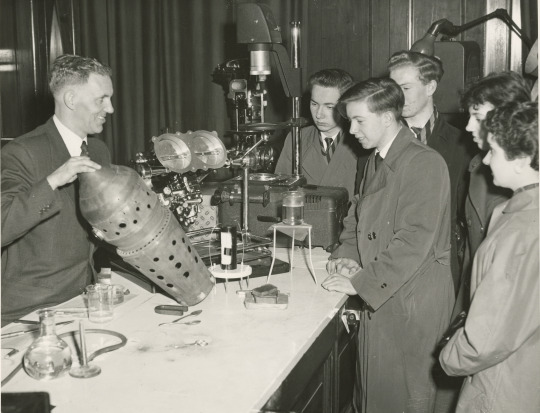
Christmas Lectures for Young People
The RTC’s annual Christmas Lectures for Young People commenced in the early 1950s, upon the suggestion of the Scottish Education Department (SED). Popular science lectures for older children were then an established feature of the Christmas season in London, and the SED, feeling that ‘Scotland was lagging behind England in this matter’, approached the Director of the RTC, Dr (later Sir) David Anderson, in 1951 with the idea of providing similar lectures for secondary school pupils in the West of Scotland.[1] Anderson responded positively, and the first Christmas Lectures for schoolchildren in Glasgow and the West of Scotland, organised by the RTC in conjunction with the SED, were delivered on 3 and 4 January 1952. The presenter, Dr Charles H. Giles of the RTC’s Department of Technical Chemistry, addressed the theme of ‘Chemistry and Colour Photography.’
Having proved successful, the lectures then became a permanent feature in the RTC calendar, taking place every December. Lectures on two different topics, delivered by separate presenters, were offered each year, with both presenters repeating their lecture a second time so that as many children as possible could attend. In session 1953-1954, external academics from the University of Edinburgh and University College, Dublin were invited to come and deliver the lectures. However, it proved so challenging for them to arrange and rehearse their practical demonstrations at the RTC in advance that, in subsequent years, the speakers were selected solely from the staff of the RTC.
The Christmas Lectures for Young People were carried on by the RTC’s successor bodies, the Royal College of Science and Technology (RCST, 1956-1964) and the University of Strathclyde (1964 onwards). While their primary purpose was to inspire and instruct children in aspects of science and technology, the lectures also served to entertain, and the presenters often chose topics that would appeal to children, such as ‘Pests and Parasites’ (1954) and the aptly named ‘Combustion – Some Burning Questions’ (1958). The photograph above shows Dr P.T. Carter, senior lecturer in the Department of Metallurgy, explaining the principles of jet and combustion engines to some of the children who heard him speak on ‘Metals in the Service of Mankind’ in December 1956 (reference: OP4/191).
[1] OE/12/12/24, Papers and correspondence relating to Christmas Lectures. Note on Christmas Lectures, c.1955.
#large#Archives and Special Collections#University of Strathclyde#EYA2022#explorearchives#Christmas#Royal Technical College#Royal College of Science and Technology#Christmas at the Tech
3 notes
·
View notes
Photo

Tribute to William Morris: tiny book with English laws. 14th c. Size of modern pencil. #medievallaw #englishlaw #uofglasgow #uofglibrary #bookhistory #bookart #medieval #medievalmanuscripts #explorearchives #archivesunlocked source: @uofgcodicologist #goodnightfriday #goodnight (at Lucca, Italy)
#medievalmanuscripts#medievallaw#uofglibrary#uofglasgow#bookart#goodnight#medieval#archivesunlocked#englishlaw#goodnightfriday#bookhistory#explorearchives
0 notes
Photo







Explore Your Archive Week: Action Archives
We have another entry for @explorearchives (twitter) #ExploreYourArchive week 2019!
Surely the acrobat group of the Milwaukee Turners (founded as the Socialer Turnverein in 1853) is a great representation of action in the archives!
The Turner movement was an ardent promoter of physical, intellectual, social, and political activity, their motto being “Sound Mind in a Sound Body.” The Milwaukee outgrowth of the Turners were highly influential throughout Milwaukee’s history and continue to be an active force in Milwaukee today!
The first photograph shown above dates from 1866 and the remainder of the photographs are from 1900. All photographs come from the Milwaukee Turners Foundation Records (PH Milwaukee Mss BM, box 5).
#UWM Archives#Milwaukee Turners#ExploreYourArchive#ActionArchives#Explore Your Archives#action archive#acrobats#gymnastics#1800s#1900s#Milwaukee#vintage photos#feats of strength#archives
68 notes
·
View notes
Photo

This document, found in the correspondence of John Ellis (1714-1776), written in Arabic, is a set of instructions on dying goat skins with kermes (a red dye made from insects). The second part gives the quantities used. #internationalarchives #explorearchives #arabicscript facebook.com/tradezara https://www.instagram.com/p/BqnKA8Ll_TE/?utm_source=ig_tumblr_share&igshid=1bvbqde3ktyqu
0 notes
Photo
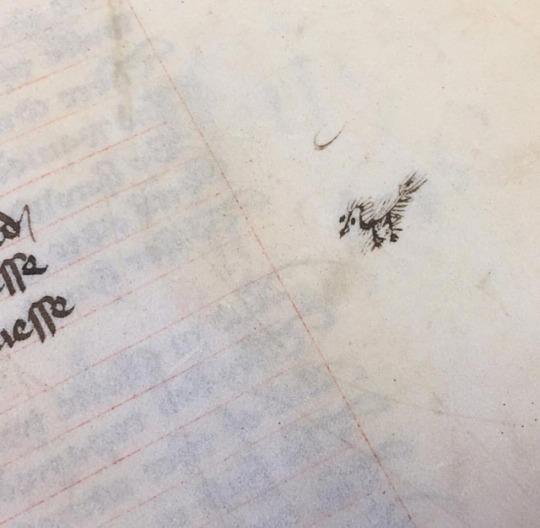
We've heard of marginalia, but might this doodler have known a Corra? . . . #Repost @uofgcodicologist ・・・ Another late night post for me this week, all because of a lot of deadlines for things that will (hopefully) let me do more research on this gloriously scruffy manuscript! Swipe through to discover one of my favourite marginal annotations which - considering this MS is STUFFED with #doodles on almost every page - is saying something! This is @uofglasgowasc MS Hunter 232 (U.3.5), a medieval MS of Lydgate's poem "The Life of Our Lady" which has been extensively annotated by early modern owners. Pen trials, marginal notes, even children's doodles fill the blank parchment of this otherwise quite plain religious MS. Most bear no relation to the text. How much do you love the expression of this marginal duck? I think this wee chap deserves a name - any suggestions? #doodles #duck #medievalduck #margins #marginalia #marginalannotations #earlymodernmarginalia #lydgate #manuscriptstudies #bookhistory #historyofthebook #annotations #uofglasgow #uofglibrary #iglibraries #specialcollections #archives #archivesofinstagram #libraries #librariesofinstagram #bookstagram #manuscripts #books #bookhistory #bookart #medieval #earlymodern #medievalmanuscripts #rarebooks #explorearchives #archivesunlocked
#bookstagram#archivesofinstagram#archivesunlocked#margins#earlymodern#rarebooks#explorearchives#bookart#uofglasgow#marginalia#lydgate#specialcollections#archives#librariesofinstagram#medieval#medievalduck#bookhistory#uofglibrary#duck#manuscripts#medievalmanuscripts#manuscriptstudies#historyofthebook#books#marginalannotations#annotations#libraries#doodles#earlymodernmarginalia#iglibraries
0 notes
Text
The lamentable death of Pryse Pryse - Master of the Hunt. Killed by a fox. #ExploreArchives https://t.co/GmrSxntAxI https://t.co/aeFnmsyIAc
The lamentable death of Pryse Pryse - Master of the Hunt. Killed by a fox. #ExploreArchives https://t.co/GmrSxntAxI pic.twitter.com/aeFnmsyIAc
— Jason Evans (@WIKI_NLW) November 26, 2019
via Twitter https://twitter.com/WIKI_NLW
0 notes
Photo



Humphry Davy, one of history’s finest scientists, travelled through Britain and Europe like most independent men of the time. As he went, he recorded the wonders he saw with sketches in pencil and iron gall ink. With a scientist’s approach, he had an eye for native animals as well as landscapes. These sketches are of a bird from a trip to Italy, a quick sketch of a dragonfly and a pencil and watercolour fish, all stored in the Ri collections.
#ArchiveAnimal#explorearchives#Royal Institution#scientific illustration#animals#Humphry Davy#archives#manuscript#salmon#dragonfly#carrerra#iron gall ink#watercolour#illustration#science
187 notes
·
View notes
Text
Christmas at the Tech, 1912-1963 - Part 1: Students’ Christmas Ball and Children’s Christmas Party
With Christmas time approaching and most of Strathclyde’s students and staff back on campus following the pandemic, many in-person celebrations and festive activities are being planned for the first time in several years. This series of three blog posts looks back at some of the Christmas activities associated with Strathclyde’s antecedent institution, the Royal Technical College (RTC), renamed in 1956 as the Royal College of Science and Technology (RCST) and popularly known as ‘the Tech’. We begin by considering two of the most eagerly anticipated events of all: the students’ Christmas Ball and the Children’s Christmas Party.
Christmas Ball
Organised annually by the Students’ Representative Council (SRC), the Christmas Ball was a major event in the RTC and RCST social calendar and provided a welcome opportunity for students to let their hair down following the end of term exams. To encourage ticket sales, the SRC’s Dance Committee publicised the Ball in the student magazine, The Mask, and in the student newspaper, the Telegraph. The advertisement below was placed in the December 1938 issue of The Mask (reference: OJD/1/2/76).
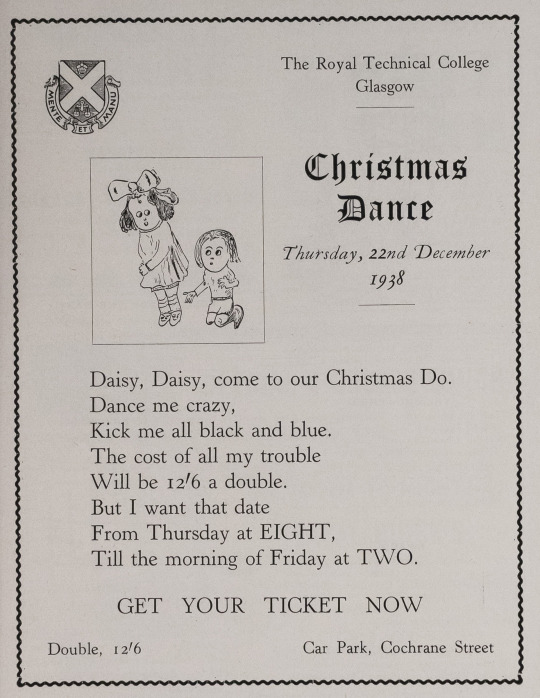
The Dance Committee (later the Entertainments Committee) invested considerable time and effort to ensure the Ball’s success. In the early years, a hotel in central Glasgow would be booked to host the event: in 1926, for example, the Christmas Dance took place at the Grand Hotel, and in 1930 and 1931 the venue was the Ca’ D’Oro Ballroom. By the 1940s, however, the Christmas Ball generally took place in the RTC’s own Assembly Hall, which doubled as the Exam Hall. The new Student Union building in John Street, which was opened in 1959, later provided appropriate facilities for hosting the Ball and similar functions.
When the Ball was held on campus, the Committee had the unenviable task of decorating the hall for the occasion. In 1944, the RTC’s Navigation Department loaned them some flags for this purpose, ‘and it was [also] decided that the members of the Dance committee should look around the local shops for streamers etc’.[1] In subsequent decades, as the numbers of students studying at the RTC expanded, more resources were available and the new Union building offered increased space and scope for decorations, the Committee’s plans became more ambitious. The early 1960s saw the Christmas Ball organised according to a different theme each year, ranging from ‘Arctic Aurora’ (1960) and ‘Tropical Bally-Ho!’ (1961) to ‘Neptune’s Nocturnals’ (1962: programme pictured below, reference OJA/18/2/3) and ‘Black Friday’ (1963).
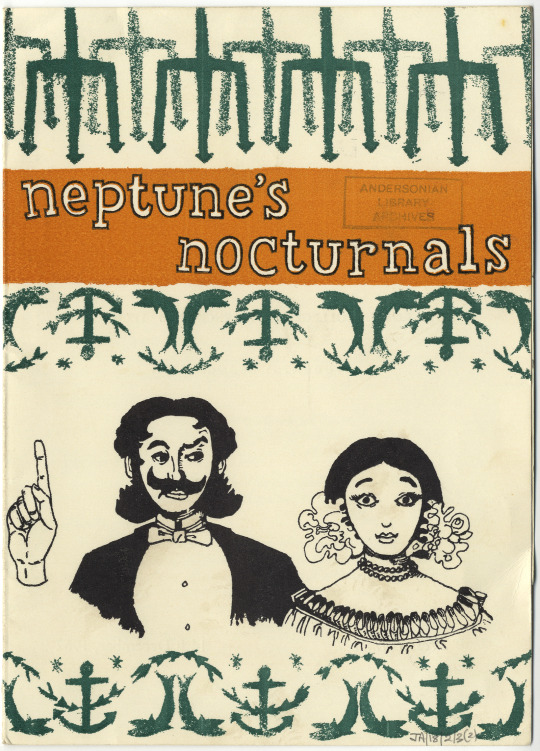
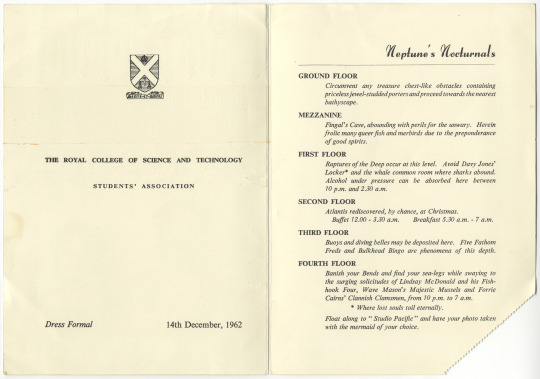
Designing and constructing props and decorations for a themed event demanded specific skills for which the Committee turned to members of the Architecture and Building Society, the RCST’s club for architecture students.[2] As the Committee minutes show, the ‘Architects’ club’ chose the theme for the Ball from a shortlist of suggestions supplied to them by the Committee, opting for that which offered the best artistic and practical possibilities.[3] As well as designing and building the set and props, the architecture students also designed the Ball tickets. Unfortunately, we have no photographs of the themed sets and decorations, but they were impressive, at least according to the writer of this letter in the student newspaper of 13 January 1961:
Dear Madam, I feel I must write an appreciation of the decorations for the Christmas Ball. The Assembly Hall and the Fourth Floor landing, were masterpieces in decoration and the spiral of tinsel down the stair well was a magnificent welcome on entering the building. The Architects who de- -signed the “set” as it were, and also everyone who helped in any way with the decorating of the building are to be congratulated on their wonderful achievements. I must, however, deplore the practice carried out at the Ball itself, of stripping the Christmas tree in the Dining Hall of its tinsel so that the female participants in the Ball might be decorated still further. Not only is this tinsel costly, but it did not greatly enhance the coiffures of the ladies who were seen wearing it. To conclude, thanks to the architects, for the splendid decorations and no thanks to those members who spoiled it slightly by ruining the Tree.[4]
The Committee’s labours did not end with decorating the hall, for one of their most important tasks was to engage a suitable band or bands for the evening. The 1950s and 1960s saw combinations of dance bands and jazz bands booked to play at the Ball; by the early 1960s, an additional ‘beat band’ was also booked to play during the interval. The Committee was further responsible for hiring caterers to provide a buffet; arranging the provision of at least one liquor bar; and organising screenings of several short films (mostly cartoons) in rooms adjacent to the main dance hall. If funds permitted, the evening’s entertainment would extend to a cabaret: a ‘Malayan fire eater’, who also performed hypnotism, was booked as the cabaret artist for the Christmas Ball in 1961.[5] Less spectacular (and less dangerous) amusements were also laid on for that year’s event, including ‘Enticing Bingo Sessions’.[6]
As the decades progressed, so too did the hour at which the Ball concluded. In the 1930s, the event tended to finish at 2.00am. In 1944, the students sought permission for the Ball to last all night, but the RTC’s Director, Sir Arthur Huddleston, was averse to the idea.[7] By the late 1950s, however, the Ball was generally scheduled to conclude at 6.00am and ‘breakfast tickets’ were available, entitling each holder to enjoy a hot meal in the early morning before making their way home.[8] In 1960, a double ticket for the Ball cost 25/ and a breakfast ticket cost 3/6d.
Annual Children’s Christmas Party
As well as a Christmas Ball for the students, the Students’ Representative Council of the RTC and RCST organised an annual Christmas party for younger children from local children’s homes, held in the Students’ Union. Transport and catering costs for this event were met from the proceeds of Wednesday lunchtime showings of Fred Quimby’s Tom and Jerry cartoons, organised by the Entertainments Committee. Each student attending the ‘Freds’, as these cartoon screenings were known, was asked to give a donation of 3d.[9]
According to this report in the student newspaper of 13 January 1961, the children’s party was a loud, frenetic, but happy occasion:
The Children’s party was held in the Union on Wednesday the 28th December. Children from homes and orphanages in Glasgow as well as the children of Union employees were given a first class treat. [To] The music played by the members of the College Music Society, the children enjoyed all their favourite singing games i.e. “The Farmer Wants a Wife”, “The Grand Old Duke of York”, and “Pass the Parcel”. The band survived although surrounded by hosts of inquisitive children who found the microphone a very intriguing gadget. Lemonade, cakes, jelly, fruit and ice cream disappeared at an alarming rate. The children had a break from balloon bursting and musical games in an excellent little film show. Then Santa, alias Ian McClure, gave them each a present before they went home.[10]
A more candid report of the same event appears in another section of the newspaper, revealing that, due to an outbreak of mumps among the younger children at one of the homes, a group of 14-year-olds had been dispatched to attend the party in place of the usual 3-8-year-olds. Unsurprisingly, ‘They did not appreciate the Farmer wants a Wife as much as usual and Santa felt perhaps just the tiniest bit embarrassed . . . by giving “Bunny Painting Books” to mature youths. Luckily they were wrapped.’[11] Despite this hiccup, the annual party was both a welcome source of diversion and entertainment for the children, and a rewarding, if physically exhausting afternoon for their student hosts.
Today, Strathclyde’s students and staff continue to bring Christmas cheer to disadvantaged children in Glasgow through the University’s annual Christmas Toy Appeal. Since its inception in 2016, the appeal has provided approximately 8,000 gifts of toys, which have been distributed to six schools and nurseries and 14 charities. Staff and students wishing to participate in this year’s appeal may hand in donations of new, unwrapped toys to the University of Strathclyde Library until 12 December. Cash donations may also be made by following this link: https://onlineshop.strath.ac.uk/product-catalogue/student-experience/widening-access/christmas-toy-appeal-2022.
[1] OJA/6/1, Students’ Representative Council Dance Committee minute book, 1941-1946: minute of meeting on 10 November 1944.
[2] OJA/6/3, Students’ Representative Council Entertainments Committee minute book, 1958-1964: minute of meeting on 24 October 1960, p.92.
[3]OJA/6/3, Students’ Representative Council Entertainments Committee minute book, 1958-1964: minute of meeting on 9 November 1962, p.214.
[4] OJD/3/1, Telegraph vol.1, no.12, 13 January 1961, p.4.
[5] OJA/6/3, Students’ Representative Council Entertainments Committee minute book, 1958-1964: minute of meeting on 9 November 1962, pp.214-216.
[6] OJD/3/2, Telegraph vol.2, no.7, 8 Dec 1961, p.1.
[7] OJA/6/1, Students’ Representative Council Dance Committee minute book, 1941-1946: minute of meeting on 10 November 1944.
[8] OJA/6/3, Students’ Representative Council Entertainments Committee minute book, 1958-1964: minute of meeting on 4 November 1958, p.8.
[9] OJD/3/1, Telegraph vol.1, no.12, 13 January 1961, p.5; OJA/6/3, Students’ Representative Council Entertainments Committee minute book, 1958-1964: minute of meeting on 4 November 1959, p.44.
[10] OJD/3/1, Telegraph vol.1, no.12, 13 January 1961, pp.3-4.
[11] OJD/3/1, Telegraph vol.1, no.12, 13 January 1961, p.5.
#large#Archives and Special Collections#University of Strathclyde#EYA2022#explorearchives#explore your archive#Christmas#20th century#Royal Technical College#Royal College of Science and Technology#Christmas at the Tech
3 notes
·
View notes
Photo





In celebration of Native American Heritage Month these photographs are from the Unitarian Service Committee’s work with the Navajo in the 1950s in the Southwest.
For more images from this collection, check out our post from last year.
#explorearchives#native american heritage month#navajo#unitarian service committee#uu#1950s#bMS 16199#manuscripts and archives
116 notes
·
View notes
Photo

Book now to explore your archive and learn how to read early Scottish handwriting! Thursday 19 November, 2pm @ Dumbarton Heritage Centre
0 notes